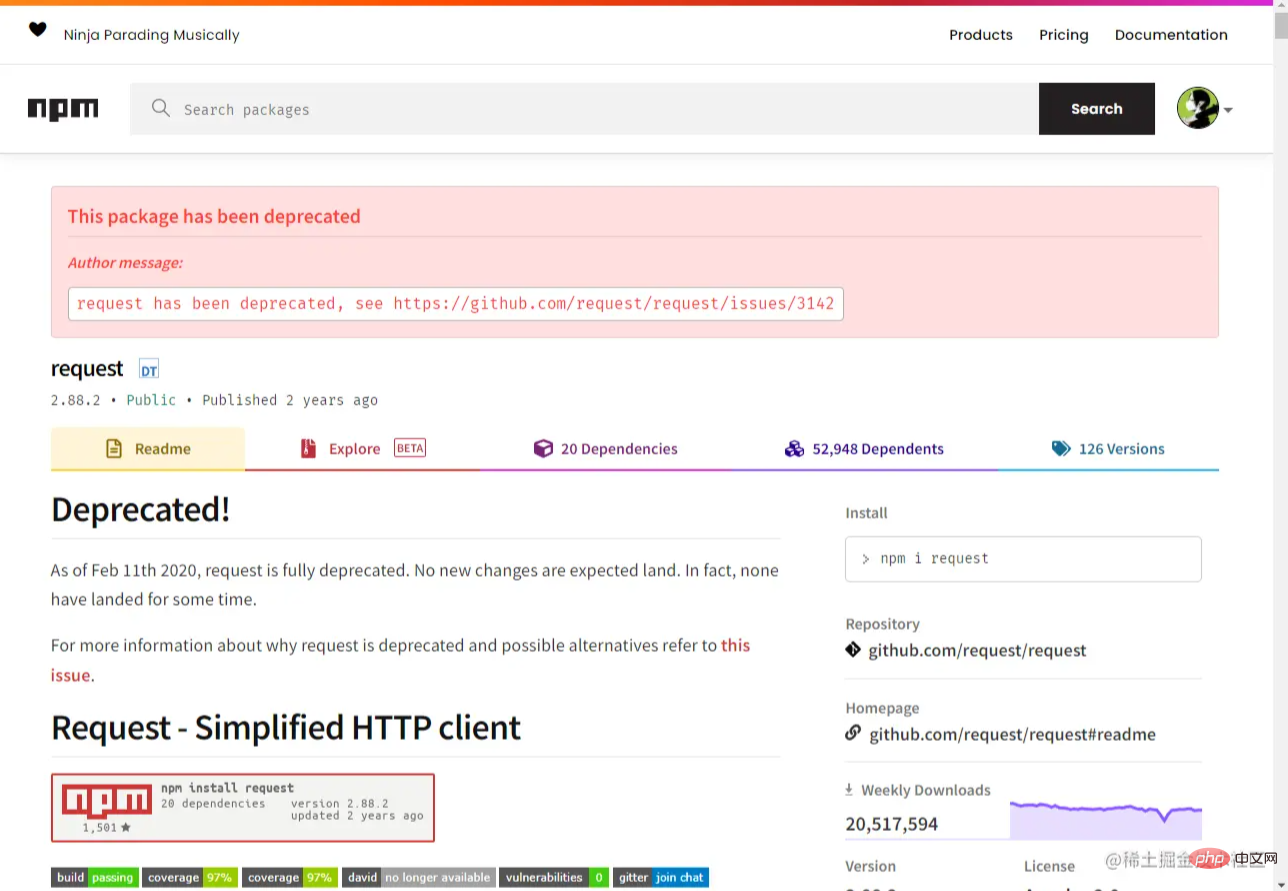A brief analysis of 6 ways Node initiates HTTP requests
How to initiate an HTTP request in Node? This article will explore with you the 6 different methods of Node to initiate HTTP requests. I hope it will be helpful to you!

This article introduces 6 different methods of initiating HTTP requests in nodejs. Here we will dig through The request of Jin Community’s section classification interface is used as a demonstration to complete the use of each different method. Of course, in order to print out the obtained data more clearly, we need to install the chalk library in advance. Add color to the printed data, okay, we are about to start~ [Related tutorial recommendations: nodejs video tutorial, Programming teaching]
Text
Node.js HTTPS Module
##Node.js There is an https module in the standard library, so you don't need to introduce any library to initiate requests, because node.js can do it by itself, and it is more than enough to handle some simple data requests. const chalk = require("chalk")
const https = require('https')
https.get('https://api.juejin.cn/tag_api/v1/query_category_briefs', res => {
let list = [];
res.on('data', chunk => {
list.push(chunk);
});
res.on('end', () => {
const { data } = JSON.parse(Buffer.concat(list).toString());
data.forEach(item => {
console.log(`${chalk.yellow.bold(item.rank)}.${chalk.green(item.category_name)}`);
})
});
}).on('error', err => {
console.log('Error: ', err.message);
});
Axios
I believe that front-end friends are no strangers to axios, it is a very popular And the popular Promise request library. It can be used on both the browser and the client, and as we all know, it also has very convenient functions such as interceptors and automatic data conversion to json.We can use the following command to install axios:
npm i -S axios
The following is a simple example of how we obtain the Nuggets plate classification through axios:
const chalk = require("chalk")
const axios = require('axios');
axios.get('https://api.juejin.cn/tag_api/v1/query_category_briefs')
.then(res => {
const { data } = res.data
data.forEach(item => {
console.log(`${chalk.yellow.bold(item.rank)}.${chalk.green(item.category_name)}`);
})
})
.catch(err => {
console.log('Error: ', err.message);
});
Got
got claims to be “a user-friendly and powerful HTTP request for Node.js "Library" is user-friendly because it uses Promise-style APIs and JOSN processing configuration functions. However, some capabilities such as HTTP2 support, paging API and RFC caching are not available in most request libraries.We can use the following command to install got:
npm i -S got@10.7.0
The following is a simple example of how we get the Nuggets plate classification through got:
const chalk = require("chalk")
const got = require('got');
got.get('https://api.juejin.cn/tag_api/v1/query_category_briefs', {
responseType: 'json'
})
.then(res => {
const { data } = res.body
data.forEach(item => {
console.log(`${chalk.yellow.bold(item.rank)}.${chalk.green(item.category_name)}`);
})
})
.catch(err => {
console.log('Error: ', err.message);
});{responseType: 'json'}, and then the returned data can be obtained in the body, which is also very easy to use.

Needle##needle is a relatively simple and compact request library. Its form can be Promise The method can also be a callback function, which depends on your own habits, and its return value will automatically convert XML and JSON, which is also very convenient.
We can use the following command to install needle:npm i -S needle
const chalk = require("chalk")
const needle = require('needle');
needle.get('https://api.juejin.cn/tag_api/v1/query_category_briefs', (err, res) => {
if (err) return console.log('Error: ', err.message);
const { data } = res.body
data.forEach(item => {
console.log(`${chalk.yellow.bold(item.rank)}.${chalk.green(item.category_name)}`);
})
})
 If you want to use Promise, you can write like this:
If you want to use Promise, you can write like this:
needle('get', 'https://api.juejin.cn/tag_api/v1/query_category_briefs')
.then(function(res) {
// ...
})
.catch(function(err) {
// ...
});SuperagentThe request library superagent was released quite early, dating back to 2011, but it is a progressive client HTTP request library that supports many advanced HTTP client functions with the Node.js module with the same API. Still very useful.
We can install superagent using the following command:下面是我们通过superagent获取掘金板块分类简单示例: 现在的superagent用法与axios十分的相似,但是需要去自己把数据处理成json格式。 顾名思义,这个请求库它的api与window.fetch保持了一致,也是promise式的。最近非常受欢迎,但可能最大的问题是,它的v2与v3版差异比较大,v2保持着cjs标准,而v3则用了ejs的方式,升级后可能造成一些困扰,所以为了统一这个标准我们这里用了2.6.7版作为演示版本。 我们可以使用以下命令安装node-fetch: 下面是我们通过node-fetch获取掘金板块分类简单示例:npm i -S superagent
const chalk = require("chalk")
const superagent = require('superagent');
superagent.get('https://api.juejin.cn/tag_api/v1/query_category_briefs')
.then(res => {
const { data } = JSON.parse(res.text)
data.forEach(item => {
console.log(`${chalk.yellow.bold(item.rank)}.${chalk.green(item.category_name)}`);
})
})
.catch(err => {
console.log('Error: ', err.message);
});
Node-fetch
npm i -S node-fetch@2.6.7
const chalk = require("chalk")
const fetch = require("node-fetch")
fetch('https://api.juejin.cn/tag_api/v1/query_category_briefs', {
method: 'GET'
})
.then(async res => {
let { data } = await res.json()
data.forEach(item => {
console.log(`${chalk.yellow.bold(item.rank)}.${chalk.green(item.category_name)}`);
})
})
.catch(err => {
console.log('Error: ', err.message);
});
可以看出它与window.fetch用起来完全一样,没有任何学习压力。

对比
接下来我们看一下关于这几款请求库近一年的下载量趋势图:

现在我们可以发现,就下载量而言,在过去一年中,node-fetch 最受欢迎,needle 最不受欢迎。
| Stars | Version | Unpacked Size | Created Years | |
|---|---|---|---|---|
| axios | 91,642 | 0.26.1 | 398 kB | 2014 |
| got | 10,736 | 12.0.1 | 244 kB | 2014 |
| needle | 1,446 | 3.0.0 | 227 kB | 2012 |
| superagent | 15,928 | 7.1.1 | 581 kB | 2011 |
| node-fetch | 7,434 | 3.2.3 | 106 kB | 2015 |
这里我们又统计了这几个库的其他一些数据,axios的star数量可谓一骑绝尘,远远超过其他几个库。
结语
这些请求库,他们都做了同一件事都可以发起HTTP请求,或许写法会有些许不同,但都是条条大路通罗马。就个人而言,也可能是经常写浏览器端的缘故,所以是axios的忠实用户,不管是练习还是开发axios都是首选,当然node-fetch也越来越收到关注,包也十分的小,练习的时候也会经常用到,但api使用起来感觉还是没有axios那般方便。
其实还有两个出名的HTTP请求库本文没有提到:
一个是ky.js,它是一个非常小巧且强大的fetch式的请求库,主要为deno和现代浏览器所打造,所以暂时不参与其中的讨论,感兴趣的同学自己探索。
另一个就是request.js,没有说的原因是它在2020年的时候就已经被完全弃用了,如果有使用过的小伙伴可以在把项目里的request它替换成其他的方法。

更多node相关知识,请访问:nodejs 教程!
The above is the detailed content of A brief analysis of 6 ways Node initiates HTTP requests. For more information, please follow other related articles on the PHP Chinese website!

Hot AI Tools

Undresser.AI Undress
AI-powered app for creating realistic nude photos

AI Clothes Remover
Online AI tool for removing clothes from photos.

Undress AI Tool
Undress images for free

Clothoff.io
AI clothes remover

AI Hentai Generator
Generate AI Hentai for free.

Hot Article

Hot Tools

Notepad++7.3.1
Easy-to-use and free code editor

SublimeText3 Chinese version
Chinese version, very easy to use

Zend Studio 13.0.1
Powerful PHP integrated development environment

Dreamweaver CS6
Visual web development tools

SublimeText3 Mac version
God-level code editing software (SublimeText3)

Hot Topics
 What does http status code 520 mean?
Oct 13, 2023 pm 03:11 PM
What does http status code 520 mean?
Oct 13, 2023 pm 03:11 PM
HTTP status code 520 means that the server encountered an unknown error while processing the request and cannot provide more specific information. Used to indicate that an unknown error occurred when the server was processing the request, which may be caused by server configuration problems, network problems, or other unknown reasons. This is usually caused by server configuration issues, network issues, server overload, or coding errors. If you encounter a status code 520 error, it is best to contact the website administrator or technical support team for more information and assistance.
 Cause analysis: HTTP request error 504 gateway timeout
Feb 19, 2024 pm 05:12 PM
Cause analysis: HTTP request error 504 gateway timeout
Feb 19, 2024 pm 05:12 PM
Brief introduction to the reason for the http request error: 504GatewayTimeout: During network communication, the client interacts with the server by sending HTTP requests. However, sometimes we may encounter some error messages during the process of sending the request. One of them is the 504GatewayTimeout error. This article will explore the causes and solutions to this error. What is the 504GatewayTimeout error? GatewayTimeo
 Solution: Socket Error when handling HTTP requests
Feb 25, 2024 pm 09:24 PM
Solution: Socket Error when handling HTTP requests
Feb 25, 2024 pm 09:24 PM
http request error: Solution to SocketError When making network requests, we often encounter various errors. One of the common problems is SocketError. This error is thrown when our application cannot establish a connection with the server. In this article, we will discuss some common causes and solutions of SocketError. First, we need to understand what Socket is. Socket is a communication protocol that allows applications to
 Understand common application scenarios of web page redirection and understand the HTTP 301 status code
Feb 18, 2024 pm 08:41 PM
Understand common application scenarios of web page redirection and understand the HTTP 301 status code
Feb 18, 2024 pm 08:41 PM
Understand the meaning of HTTP 301 status code: common application scenarios of web page redirection. With the rapid development of the Internet, people's requirements for web page interaction are becoming higher and higher. In the field of web design, web page redirection is a common and important technology, implemented through the HTTP 301 status code. This article will explore the meaning of HTTP 301 status code and common application scenarios in web page redirection. HTTP301 status code refers to permanent redirect (PermanentRedirect). When the server receives the client's
 Set query parameters for HTTP requests using Golang
Jun 02, 2024 pm 03:27 PM
Set query parameters for HTTP requests using Golang
Jun 02, 2024 pm 03:27 PM
To set query parameters for HTTP requests in Go, you can use the http.Request.URL.Query().Set() method, which accepts query parameter names and values as parameters. Specific steps include: Create a new HTTP request. Use the Query().Set() method to set query parameters. Encode the request. Execute the request. Get the value of a query parameter (optional). Remove query parameters (optional).
 Python HTTP Request Optimization Guide: Improve the Performance of Your Web Applications
Feb 24, 2024 pm 02:40 PM
Python HTTP Request Optimization Guide: Improve the Performance of Your Web Applications
Feb 24, 2024 pm 02:40 PM
Optimizing the performance of pythonHttp requests is crucial to improving the speed and responsiveness of web applications. This guide will introduce some tips and best practices for optimizing Python HTTP requests to help you improve the performance of your network applications. 1. Use connection pooling. Connection pooling is a mechanism for managing HTTP connections. It can reduce the overhead of creating and destroying connections, thereby improving the performance of HTTP requests. Python provides the requests library, which has built-in connection pool support. You only need to pass in the pool_connections parameter when creating a Session object to enable the connection pool. importrequestssession=requests.Session(
 Pi Node Teaching: What is a Pi Node? How to install and set up Pi Node?
Mar 05, 2025 pm 05:57 PM
Pi Node Teaching: What is a Pi Node? How to install and set up Pi Node?
Mar 05, 2025 pm 05:57 PM
Detailed explanation and installation guide for PiNetwork nodes This article will introduce the PiNetwork ecosystem in detail - Pi nodes, a key role in the PiNetwork ecosystem, and provide complete steps for installation and configuration. After the launch of the PiNetwork blockchain test network, Pi nodes have become an important part of many pioneers actively participating in the testing, preparing for the upcoming main network release. If you don’t know PiNetwork yet, please refer to what is Picoin? What is the price for listing? Pi usage, mining and security analysis. What is PiNetwork? The PiNetwork project started in 2019 and owns its exclusive cryptocurrency Pi Coin. The project aims to create a one that everyone can participate
 http request 415 error solution
Nov 14, 2023 am 10:49 AM
http request 415 error solution
Nov 14, 2023 am 10:49 AM
Solution: 1. Check the Content-Type in the request header; 2. Check the data format in the request body; 3. Use the appropriate encoding format; 4. Use the appropriate request method; 5. Check the server-side support.






